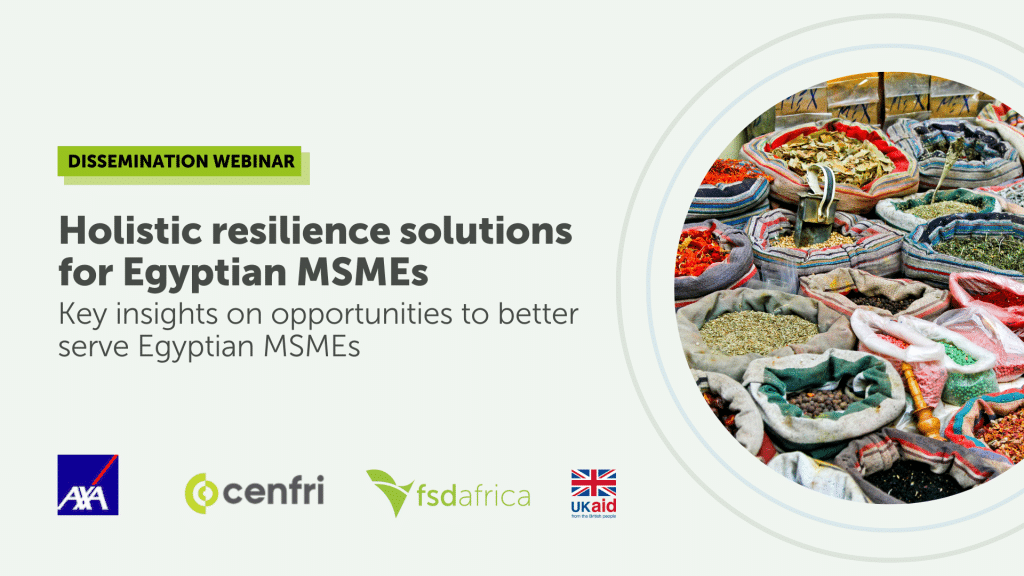Pillar: Adaptation and Resilience
This report sketches an insurance innovation portrait for Kenya, as part of an eight-country study to determine what regulators can do to unlock innovation at scale to meet key insurance needs in sub-Saharan Africa.
A large and diverse market. Kenya has the fourth largest insurance market penetration in Africa. The market spans 56 insurance companies, 5 reinsurance companies, 12,708 intermediaries and 376 insurance service providers skewed towards the general insurance market. Compulsory lines, such as third-party motor insurance, play a prominent role in the market, as does corporate-based general, life and health insurance.
Limited retail reach. The National Hospital Insurance Fund reaches 23.4 million Kenyans. Beyond that, retail insurance market reach is limited, especially for rural women and MSMEs.
Numerous innovation efforts, but not yet paying off at scale. The insurance uptake gap signals an innovation gap and trap. Kenya has a history of a drive for inclusive insurance innovation, with numerous microinsurance, index insurance and m-insurance pilots over the years. More recently, there has been increased emphasis on the role of insurtechs to drive insurance digitalisation. Overall, however, the market remains conservative, and innovation is not yet part of the core market fabric. New tech players among other factors[1] struggle to access funding and secure viable partnerships, while insurers remain subject to distribution and premium collection challenges in reaching beyond the high-end retail and urban market.
A largely enabling environment, but gaps remain. An assessment of the innovation enabling ecosystem shows that:
- The underlying electricity and mobile network infrastructure is a boon for innovation in Kenya, but challenges in deepening and modernising financial market infrastructure remain.
- Access to technical insurance and science, technology, engineering and mathematics (STEM) skills remains a constraint to innovation.
- Insurance awareness and trust need to be built further.
- Effective partnership formation remains a key challenge, especially for new players (i.e. insurtechs) seeking a foothold in the market.
- The regulatory environment is largely enabling. There is a growing regulatory focus on access, usage and quality of insurance services. Recent introductions of a microinsurance licence category and provisions for remote/digital distribution are also a case in point.
- The Insurance Regulatory Authority (IRA) has taken positive strides in enabling insurance innovation through proactive industry engagements, accelerator programmes and a regulatory sandbox, and has streamlined its internal processes to be more responsive, strategically, to innovation.
[1] Other challenges faced by new tech players include innovative business solutions especially in product development, use of massive data sets available, underwriting, pricing risk and distribution of insurance products.
Recent years have seen large scale de-risking and financial exclusion happening in developing countries, particularly those countries that most need capital flows to finance social services, aid and development.
Where regional economic hubs are de-risked, it has a profound effect on the developmental outcomes for the hub itself as well as the spoke countries it is integrated with.
To stem the risk of illicit financial flows (IFFs), the threat of being de-risked and the corresponding knock-on effect on capital flows, it is important to ensure that there are adequate regulatory frameworks in place to promote a robust level of financial integrity in a way that does not undermine inclusion.
This two-note series explores the effect of de-risking and illicit financial flows on capital markets and the role of regional economic hubs to address financial integrity issues.
The previous note highlights the relationship between de-risking, illicit financial flows and capital flows in the context of regional economic hubs.
In this second note, Identifying regional economic hubs in Africa, dives into the concept of a regional economic hub, exploring the methodologies for determining which countries are hubs within their respective regions.
Despite the importance of hub economies, very little has been published on the identification and analysis of hub systems in sub-Saharan Africa. Regional economic hubs can be defined as countries that play a significant role in the economy of the broader region and have been found to help facilitate the movement of capital. They tend to have the most developed financial markets in the region as well as more favourable or developed regulatory environments. Hence, they act as gateways for capital to flow into the countries they are integrated with (i.e. their spoke countries). This interconnection between regional economic hubs and spokes can help create stable financial flows for countries in a region and contribute to the development of their financial systems.
This work forms part of the Risk, Remittances and Integrity programme in partnership Cenfri.
Recent years have seen large scale de-risking and financial exclusion happening in developing countries, particularly those countries that most need capital flows to finance social services, aid and development.
Where regional economic hubs are de-risked, it has a profound effect on the developmental outcomes for the hub itself as well as the spoke countries it is integrated with.
To stem the risk of illicit financial flows (IFFs), the threat of being de-risked and the corresponding knock-on effect on capital flows, it is important to ensure that there are adequate regulatory frameworks in place to promote a robust level of financial integrity in a way that does not undermine inclusion.
This two-note series explores the effect of de-risking and illicit financial flows on capital markets and the role of regional economic hubs to address financial integrity issues.
This note highlights the relationship between de-risking, illicit financial flows and capital flows in the context of regional economic hubs.
The next note, Identifying regional economic hubs in Africa, dives into the concept of a regional economic hub, exploring the methodologies for determining which countries are hubs within their respective regions.
Capital flows, or moves between capital-rich and capital-poor countries depending on the opportunities for return on investment, and are important for economic development. These capital flows can consist of official capital flows, which include official development assistance and aid in the form of grants or loans, as well as private capital flows such as bank and trade-related lending, foreign direct investment, portfolio investments and workers’ remittances. Foreign direct investment (FDI), foreign aid and remittances are the major capital inflows in Africa. Such inflows play an important role in regional economic development. Between 2000 and 2017, FDI contributed an average of 3.4% to regional GDP in sub-Saharan Africa, with foreign aid and remittances contributing an average of 3.3% an2.3% respectively. These capital flows support job creation, skills and technology transfer, provide financing for government budgets and contribute to long-term economic growth. Capital flows are affected by the risk or perceived risk of illicit financial flows. Regional economic hubs can act as channels for IFFs, thereby in effect regionalising IFFs.
While Note 1 relies on the methodologies explored and utilised, Note 2, provides more details and specifics on the concept of economic hubs.
This work forms part of the Risk, Remittances and Integrity programme in partnership Cenfri.









